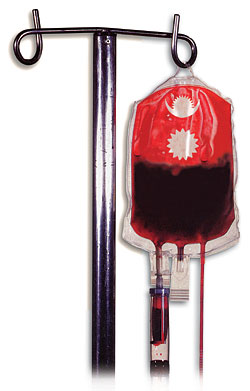 It is when your country starts making it regularly to the News Bar on CNN that you know it has hit the big time. In the past year, Nepal has been seen scrolling across the bottom of the screen with breaking news of some disaster or another. Whether it is manmade or natural, none of the news is good news.
It is when your country starts making it regularly to the News Bar on CNN that you know it has hit the big time. In the past year, Nepal has been seen scrolling across the bottom of the screen with breaking news of some disaster or another. Whether it is manmade or natural, none of the news is good news. You don't make it to the News Bar with a story on how tourists are beginning to return to Nepal this season. No, it has to be a plane crash. You don't make it to the news with the opening of a new hospital. It has to be on the latest village to be wiped off the map by a landslide.

That is the way the business is: news is whatever is negative, out of the ordinary, bizarre, or celebrity-driven. Tabloid television's appetite for news is voracious. But the news menu is shrinking as producers try to cut costs by repeating the same news on the hour, every hour. Slabs of news, therefore, come off the assembly lines of the world's Perpetual News Machines, refined, sugar-coated, and packaged for a lowest global denominator in audience surveys.
Live coverage of routine trivia distorts reality by exaggerating the importance of an event. It bends the truth by selecting the negative. The mere listing of facts thus does not necessarily bring us closer to the truth. In fact, facts can distort reality. Facts, if they are selective or incomplete, can lie.
But it is really not fair to blame the international press when we are doing such a poor job right here. The media has a role in preventing conflict, but rarely do we see them fulfilling it. Mostly, the reporting begins only after the guns start blazing, by which time the momentum of war muzzles media. And we have seen time and again that even the saddest stories of human anguish and suffering of the innocent are not enough to stop conflict once it begins.
Body-bag journalism, a daily death count that reads like a cricket scoresheet, dehumanise the misery. It numbs the public into accepting violence as a way of life. It spreads bad blood and a thirst for revenge. Violence may be prolonged even by the loaded words that we choose to use: "terrorists" when it is them, "martyrs" when it is us. We legitimise slaughter by accepting propaganda, by selective coverage, by sterile, clinical listing of numbers, by sensationalism and negativity, by the absence of context.
And when we in the insular world of the media are confronted with our own deficiencies, we blame the censors. Or we hide behind journalism's traditional rules of sterile objectivity and neutrality to make ourselves a safe cocoon. What we need is a journalism of outrage: outrage at the violence, outrage at the injustice that perpetrates it, a journalism that builds public outrage against conflict.
Let us explore the causes of escalation, and the impact of our own roles. Are we doing enough to heal society's wounds, or are we rubbing salt in them? Why do we repeatedly show the bodies of the dead on television screens strewn about like water buffaloes at the Kot? How does that help restore peace?
We have a choice: media can keep on being a part of the problem. Or we can start becoming a part of the solution.


